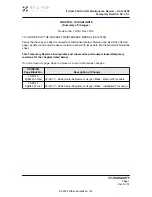
S. DRAINING BRAKE SYSTEM.
(1) Connect a hose to bleeder fitting on the bottom of the cylinder.
(2) Place other end of hose in a suitable container.
(3) Open bleeder fitting and slowly pump hand brake lever and appropriate brake pedal until fluid
ceases to flow.
(4) Clean brake system by flushing with denatured alcohol.
T. TIRES
The airplane may be equipped with either tubed or tubeless tires.
Tubeless tires are designed to permit any air or nitrogen that is trapped in the cords or that diffuses through
the liner to escape through special sidewall vents. This venting prevents pressure build-up within the cord
body which might cause tread, sidewall or ply separation. Discounting tire growth after initial inflation,
once the tire has been inflated, the maximum permissible pressure drop due to diffusion is 5% in any 24
hour period.
Vent holes penetrate the sidewall rubber to, or into, the cord body and may vary in size, depth and angle.
Therefore, the amount of diffusion through these holes will vary.
When water or a soap solution is brushed over the outside of an inflated tubeless tire, bubbles form. Some
vents may emit a continuous stream of bubbles. Others may produce intermittent bubbles. And some may
not bubble at all. This variety is normal and does not mean that there is anything wrong with the tire. In
fact, as long as a tubeless tire is inflated, there will be some diffusion from the vents. When the loss rate
exceeds 5% in 24 hours, recheck for possible injuries. Vents should remain open, so check periodically to
make sure they have not been covered over or closed by tire paint or spilled solvent. And since vents may
be covered during retreading, check for evidence that your retreads have been revented.
Several basic characteristics of tubeless aircraft tires may be mistaken for problems:
(1) Tire growth in the first 12 to 24 hours after inflation will result in a seemingly severe pressure drop.
Simply inflate, wait for another 24 hours, then check pressure. It will probably be within specs.
(2) Make sure that initial inflation is to recommended operating pressure to ensure full tire growth.
(3) It is normal for tubeless tires to show a small amount of pressure leakage throughout the life of the
tires.
tires for wear, cuts, bruises and slippage on the wheel. Check that index mark on tire is aligned with index
mark on wheel. Apply Age-Master #1 to tires to protect against ozone attack and weathering as follows:
(1) Clean oil and grease from all tire surfaces.
(2) Apply single heavy coat using brush at 0.4 - 0.5 fluid ounces per square foot. Cover surface com-
pletely and evenly; allow to dry for 5 - 10 minutes.
(3) Apply second coat per step 2; allow to dry for 20 - 30 minutes before handling.
(4) Remove agent on wheel assembly with cleaning solvent.
(5) Apply as conditions dictate.
PIPER AIRCRAFT
PA-32R-301/301T
MAINTENANCE MANUAL
12-10-00
Page 12-12
Reissued: July 1, 1993
1F15
Summary of Contents for PA-32R-301T SARATOGA S
Page 26: ...CHAPTER 4 AIRWORTHINESS LIMITATIONS 1C1 ...
Page 29: ...CHAPTER 5 TIME LIMITS MAINTENANCE CHECKS 1C4 ...
Page 53: ...CHAPTER 6 DIMENSIONS AND AREAS 1D6 ...
Page 64: ...CHAPTER 7 LIFTING AND SHORING 1D21 ...
Page 68: ...CHAPTER 8 LEVELING AND WEIGHING 1E1 ...
Page 72: ...CHAPTER 9 TOWING AND TAXIING 1E5 ...
Page 76: ...CHAPTER 10 PARKING AND MOORING 1E9 ...
Page 80: ...CHAPTER 11 REQUIRED PLACARDS 1E13 ...
Page 92: ...CHAPTER 12 SERVICING 1F1 ...
Page 126: ...CHAPTER 20 STANDARD PRACTICES AIRFRAME 1G17 ...
Page 127: ...THIS PAGE INTENTIONALLY LEFT BLANK ...
Page 139: ...CHAPTER 21 ENVIRONMENTAL SYSTEMS 1H5 ...
Page 188: ...CHAPTER 22 AUTOFLIGHT 1J7 ...
Page 193: ...CHAPTER 23 COMMUNICATIONS 1J12 ...
Page 203: ...CHAPTER 24 ELECTRICAL POWER 1J22 ...
Page 263: ...CHAPTER 25 EQUIPMENT FURNISHINGS 2A13 ...
Page 269: ...CHAPTER 27 FLIGHT CONTROLS 2A20 ...
Page 332: ...CHAPTER 28 FUEL 2D11 ...
Page 363: ...CHAPTER 29 HYDRAULIC POWER 2E18 ...
Page 404: ...CHAPTER 30 ICE AND RAIN PROTECTION 2G16 ...
Page 470: ...CHAPTER 32 LANDING GEAR 3A13 ...
Page 550: ...CHAPTER 33 LIGHTS 3D24 ...
Page 562: ...CHAPTER 34 NAVIGATION AND PITOT STATIC 3E12 ...
Page 582: ...CHAPTER 35 OXYGEN 3F8 ...
Page 604: ...CHAPTER 37 VACUUM 3G6 ...
Page 616: ...CHAPTER 39 3G18 ELECTRIC ELECTRONIC PANELS MULTIPURPOSE PARTS ...
Page 620: ...CHAPTER 51 STRUCTURES 3G22 ...
Page 636: ...CHAPTER 52 DOORS 3H14 ...
Page 650: ...CHAPTER 55 STABILIZERS 3I4 ...
Page 662: ...CHAPTER 56 WINDOWS 3I16 ...
Page 670: ...CHAPTER 57 WINGS 3I24 ...
Page 688: ...CHAPTER 61 PROPELLER 3J18 ...
Page 704: ...CHAPTER 70 STANDARD PRACTICES ENGINES 3K10 ...
Page 708: ...CHAPTER 71 POWER PLANT 3K14 ...
Page 737: ...CHAPTER 73 ENGINE FUEL SYSTEM 4A13 ...
Page 749: ...CHAPTER 74 IGNITION 4B1 ...
Page 783: ...CHAPTER 77 ENGINE INDICATING 4C11 ...
Page 793: ...CHAPTER 78 EXHAUST 4C21 ...
Page 801: ...CHAPTER 79 OIL 4D5 ...
Page 805: ...CHAPTER 80 STARTING 4D9 ...
Page 819: ...CHAPTER 81 TURBINES 4D23 ...
Page 833: ...CHAPTER 91 CHARTS WIRING DIAGRAMS 4E13 ...
















































